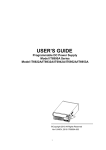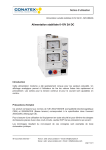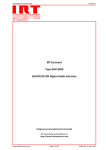Download USER MANUAL
Transcript
USER MANUAL Triple Output Programmable DC Power Supply Model LPS 305B-TC Ver1.0 / MAR, 2013 / LPS 305B-TC LPS 305B-TC SAFETY INFORMATION .................................................................................................................................................. 3 SAFETY SYMBOLS AND TERMS .................................................................................................................................. 3 CERTIFICATION AND QUALITY ASSURANCE .......................................................................................................... 4 INTRODUCTION ................................................................................................................................................................ 5 CHAPTER 1 QUICK START ............................................................................................................................................ 6 1.1 THE FRONT PANEL AND REAR PANEL DESCRIPTION .................................................................................................. 6 1.1-1 Front panel........................................................................................................................................................ 6 1.1-2 Rear panel ........................................................................................................................................................ 7 1.1-3 Dimension ......................................................................................................................................................... 8 1.2 PRELIMINARY CHECK ................................................................................................................................................. 8 1.2-1 Check the list of supplied items ..................................................................................................................... 8 1.2-2 Power on pre-check ........................................................................................................................................ 8 1.2-3 System self-test ............................................................................................................................................... 8 1.2-4 Output verification .......................................................................................................................................... 10 1.2-5 If the power supply does not turn on........................................................................................................... 11 1.2-6 How to replace the fuse ................................................................................................................................ 11 1.2-7 How to adjust the carrying handle ............................................................................................................... 12 CHAPTER 2 SPECIFICATION....................................................................................................................................... 13 2.1 SPECIFICATION ......................................................................................................................................................... 13 2.2 SUPPLEMENTAL CHARACTERISTICS ........................................................................................................................ 14 CHAPTER 3 FRONT-PANEL OPERATION ................................................................................................................. 15 3.1 FRONT-PANEL OPERATION OVERVIEW .................................................................................................................... 15 3.2 PANEL DESCRIPTION ................................................................................................................................................ 16 3.3 VFD DESCRIPTION .................................................................................................................................................. 17 3.4 MENU DESCRIPTION ................................................................................................................................................ 17 3.5 PANEL OPERATION ................................................................................................................................................... 17 3.5-1 Channel Operation ........................................................................................................................................ 17 3.5-2 Output On/Off setting .................................................................................................................................... 18 3.5-3 Set Voltage ..................................................................................................................................................... 18 3.5-4 Set Current ..................................................................................................................................................... 19 3.5-5 Save and Recall Operation .......................................................................................................................... 19 3.5-6 Limit Voltatge Protection (LVP) .................................................................................................................... 19 3.5-7 Key lock function ............................................................................................................................................ 20 3.5-8 Protections ...................................................................................................................................................... 20 3.6 MENU ITEM DESCRIPTIONS...................................................................................................................................... 20 4.1 COMMUNICATION BETWEEN POWER SUPPLY AND PC ............................................................................................ 27 4.1-1 IT-E121 communication module (RS232 to TTL) ..................................................................................... 27 4.1-2 IT-E122 communication module (USB to TTL) ......................................................................................... 27 4.2 COMMUNICATION BETWEEN POWER SUPPLY AND PC ............................................................................................. 28 USER MANUAL 2 LPS 305B-TC Safety Information Please review the following safety precautions before operating our instrument. General information Please do not install replacement parts in the instrument, or perform any unauthorized modification. Please send the instrument to B+K Precision Taiwan’s maintenance department for maintenance and for ensuring its security features. Please refer to the manual for specific information on warnings or precautions to avoid personal injury or instrument damage. The instrument does not have parts that the users can replace or perform maintenance by themselves. If maintenance service is required, please contact our company’s trained service personnel. Security regulation To prevent electric shock, a non-authorized personnel is strictly prohibited to open the instrument. Additionally, use in life support systems or any other device with security requirements is strictly prohibited. We are not liable for any direct or indirect, financial damage or profit loss that might occur when using the instrument. Safety symbols and terms Warning This product should only be used as intended. Users must be trained in electrical safety procedures and proper use of the instrument. Users must be protected from electric shock and contact with hazardous live circuits. Please observe the following precautions before using this product to avoid any instrument damage. Notes It reminds the user of some operating procedures, practices, conditions and other matters that may result in instrument damage or data loss. Connect it to safety earth ground using the wire recommended in the user manual. The symbol on an instrument indicates that the user should refer to the operating instructions located in the manual High voltage danger 3 LPS 305B-TC Certification and Quality Assurance LPS 305B-TC programmable DC power supply fully meets all of the technical specification in the manual. Warranty B+K Precision Taiwan Inc. warrants to the original purchaser that its products and component parts thereof, will be free from defects in workmanship and materials for a period of one year from the date of purchase. During this year, B+K Precision Taiwan will, without charge, repair or replace, at its option, defective product or component parts under normal operation. B+K Precision Taiwan Inc., does not take the repair-free responsibility to any one of the following situations; and will charge repair fee in accordance with the maintaining situation: (1) The product is not sold directly by B+K Precision Taiwan Inc.’s formally authorized distributor. (2) Because the irresistible calamity or force majeure, which may attribute to the user who has not followed the User Manual to operate or caused by user’s fault, such as malfunction or damage made from improper operation or others. (3) User dismantles, repairs, repacks the product, or installs additional accessories without B+K Precision Taiwan Inc.’s permission or authorization, which cause trouble or damage of the product. (4) User incorrectly or improperly repairs the product. (5) User uses his or her own software or interface. (6) Unauthorized modification or improper usage of the product. (7) User operates, assembles or repairs the product in environments and locations outside the allowable ambient environment and location. (8) User uses his or her own equipment or installs his or her own circuitry causing damages. (9) The instrument’s model number or serial number has been modified, erased, removed, or made illegible. (10) Damages caused by accidents, including but not limited to lightning strike, water damage, fire, abusive use, negligence, etc. Within warranty period, the user should be responsible and cover respective expense to transport the troubled or damaged product to B+K Precision Taiwan Inc. or the place which B+K Precision Taiwan Inc. specify. B+K Precision Taiwan Inc. will bear the expense in delivering the fixed product back to user. User shall cover for any transporting insurance from the insurance company alone. If the product is returned from countries for maintenance other than the original country, the customer should pay for the round-trip freight, duties, and all associated fees. USER MANUAL 4 LPS 305B-TC Notice The contents of this manual are subject to change without notice. Introduction B+K Precision LPS 305B-TC offers three clean, reliable outputs for general purpose applications. It delivers 0-30.5V on two outputs and 0-5.5V on one output. Each output can be operated independently, and can be connected in series or parallel to produce larger voltage or current required. Excellent stability, high precision, and high resolution (up to 10mV/1mA) are features that make LPS305B-TC ideal for R&D, schools, and production lines. The main features are as follows: Programmable triple outputs Simultaneous display of triple output voltage and current Low ripple, low noise 27 store memory and recall function VFD display 1/2 2U compact size Digital encoder knob and keypads function Key Output on/off control LVP, OVP and OTP protection Optional RS232 (IT-E121) and USB (IT-E122) interface 5 LPS 305B-TC Chapter 1 Quick Start 1.1 The front panel and rear panel description 1.1-1 Front panel 1 3 4 2 5 6 Figure 1-1 1 VFD display 2 Rotary knob 3 Power Switch, Local and Shift keys 4 Numerical and “Esc” keys 5 Function keys 6 Cursor position keys 7 Output terminals USER MANUAL 6 7 LPS 305B-TC 1.1-2 Rear panel 4 1 2 3 Figure 1-2 1 Ventilation holes 2 TTL connector port 3 110V/220V AC Power selection switch 4 AC power inlet and Fuse compartment Note: The TTL connector port is not the same as a RS232 interface. Please do not connect directly to RS232 port on PCs to avoid damage to the unit. This connector port can only be used with B+K Precision Taiwan’s optional interfaces. 7 LPS 305B-TC 1.1-3 Dimension The dimension of LPS305B-TC is as shown in the figure below: Unit:millimeter (mm) Figure 1-3 1.2 Preliminary Check The following steps will help you verify that the power supply is ready for use. 1.2-1 Check the list of supplied items Verify that you have received the following items with your power supply. If anything is missing, please contact B+K Precision Taiwan. 1. Power cord 2. User manual 3. Test report 1.2-2 Connect the power cord and turn on the power supply After power up, the instrument will automatically perform a self-test routine. In the event that there is no response when you turn on the power supply, refer to 1.2-5 for additional information. 1.2-3 System self-test USER MANUAL 8 LPS 305B-TC After power on, the front-panel display with automatically perform a self-test and the following should be displayed: Init… Figure 1-4 Followed by: 10.00V 0.000A 11.00V 3.00V 0.000A 0.000A Figure 1-5 The first row is the output voltage for channels 1-3, and the second row is the output current of each channel. ▼ pointing at CH1 means that you can set the current and voltage value of Channel 1. To switch to other channels, press the Local key. In case the self-test routine is not successful, you may see one of the following VFD displays: If EEPROM is damaged, the following will be displayed: EEP Err Figure 1-6 If the last operation data which should be stored in the EEPROM is lost, you will see: Syst Lost Figure 1-7 During channel scan, the following will be displayed: Scan Chan Figure 1-8 When checkout for one channel failed, you will see: Scan Chan Chan Lost Figure 1-9 When the calibration data of one or more channels is lost, you will see: 9 LPS 305B-TC Scan Chan Cal Lost Figure 1-10 If the factory calibration data of one or more channels is lost, you will see: Scan Chan Fact Lost Figure 1-11 1.2-4 Output verification The following procedures verify that the power supply outputs the correct voltage and current levels and properly responds to entries from the front panel. Voltage Output Check The following steps verify basic voltage functions without load. 1) Press Power key to turn on the power supply 2) Press On/Off key to enable the output Note: When key is not lit, the power supply is in SET mode, which means that the VFD displays the set values for voltage and current. When the key is lit, then the power supply is in METER mode, the actual voltage and current will be displayed on the VFD. 3) Check that the front-panel voltmeter properly responds to numerical key entries. Enter a different voltage value and wait a few seconds until the METER mode activates. Verify that the actual output value voltage is identical to the set value. Also verify that the displayed current value is close to 0A. 4) Make sure that the voltage can be adjusted from zero to the maximum rated value. 5) Check the other two channels by the same method. Current Output Check The following steps verify the basic current functions by shorting the power supply’s output. 6) Press Power key to turn on the power supply 7) Press On/Off to disable the output, ensure that the output is OFF (as shown in Figure 1-5) 8) Connect the (+) and (-) output terminals of channel 1 with a short, insulated test lead. Use a wire size sufficient to handle the maximum current. 9) Adjust the voltage value to 3V 10) Press On/Off to enable the output 11) Adjust the current: Enter a different current value, wait until the instrument is in METER mode then make sure that the displayed current value (actual output value) is the same USER MANUAL 10 LPS 305B-TC as the set value. 12) Make sure that the current can be adjusted from 0 to the full rated value 13) Disable the output and then remove the test lead 14) Check the other two channels by the same method. 1.2-5 If the power supply does not turn on Use the following steps to help resolve the problems you might encounter when turning on the instrument. 1) Verify that there is AC power applied to the power supply Verify that the power cord is firmly plugged into the power receptacle on the rear panel of the power supply. Make sure the power outlet you are using is working properly and verify that the power supply is turned on. 2) Verify the power-line voltage setting Make sure the voltage selector switch is set according to the present line voltage (110VAC or 220VAC). Change the voltage setting if it’s not correct. 3) Verify that the correct power-line fuse is installed If the fuse is damaged, please replace it according to the table below. Model LPS 305B-TC Fuse Spec Fuse 3.15A (220V AC) Fuse 6.30A (110V AC) Table 1-1 1.2-6 How to replace the fuse Open the small plastic cover below the power supply’s input socket on the rear panel with a screwdriver, you should see the fuse already in it. Please replace using a fuse according to the specification shown in the table above. 11 LPS 305B-TC 1.2-7 How to adjust the carrying handle To adjust the position, grasp the handle by the sides and pull outwards to rotate the handle. Once you have reached the desired position, push the handles in. There are three possible configurations, as shown below: Benchtop Configurations Hand Carry Configuration Figure 1-12 USER MANUAL 12 LPS 305B-TC Chapter 2 Specification 2.1 Specifications Parameters LPS305B-TC Output Ratings Voltage 0~30.5V×2,0~5.5V×1 (0 °C - 40 °C) Current 0~3A×2,0~3A×1 Load Regulation Voltage ≤0.02%+4mV Current ≤0.2%+3mA Voltage ≤0.01%+3mV Current ≤0.2%+3mA Voltage 10mV Current 1mA Voltage 10mV Current 1mA Voltage ≤0.06%+20mV Current ≤0.2%+10mA Voltage ≤0.06%+20mV Current ≤0.2%+10mA (% of output+offset) Line Regulation (% of output+offset) Programming Resolution Readback Resolution Programming Accuracy (Within 12 months) (25 °C ± 5 °C) (% of output+offset) Readback accuracy (25 °C ± 5 °C) (% of output+offset) Ripple and Noise Temperature Coefficient Normal Mode Voltage ≤1mVrms/5mVp-p Normal Mode Current ≤6mArms Voltage 250ppm/°C (% of output+offset) Current 250ppm/°C Readback Temperature Coefficient Voltage 250ppm/°C (% of output+offset) Current 250ppm/°C Voltage ≤0.5%+30mV Current ≤0.2%+15mA Voltage ≤0.2%+30mV Current ≤0.2%+25mA Save/Recall 27 sets (0 °C ~ 40 °C) Series Accuracy Parallel Accuracy Memory Dimensions 214.55mm(W) x 88.2mm(H) x 354.6mm(D) Weight 7.4 kg Table 2-1 13 LPS 305B-TC 2.2 Supplemental Characteristics Recommended Calibration Interval 1 year AC Input Ratings (selectable via switch on the rear panel) Option 01: 220V AC ± 10%, 47 to 63 Hz Option 02: 110V AC ± 10%, 47 to 63 Hz Max input power Model# LPS305B-TC Power 750VA Table 2-2 Cooling Fan cooled Operating Temperature 0 to 40 °C for max rated output Storage temperature -20 to 70 °C Environmental conditions Indoor use only, max humidity 80%, no condensation. USER MANUAL 14 LPS 305B-TC Chapter 3 Front-Panel Operation So far we have covered the quick start chapter which briefly introduced the front panel operation and how to check basic voltage and current functionality. This chapter describes in detail how to operate the instrument manually via the front-panel keys. 3.1 Front-panel Operation Overview The power supply is shipped from the factory ready for front-panel operation Set mode. At power-on, the power supply will automatically enter the Set mode and the instrument can be controlled via the front panel keys and knob. THE VFD will display the set voltage and current. The power supply enters remote mode as soon as a valid remote command is received via the communication connector in the rear. Switching to remote mode does not impact the supply’s output parameters. In remote mode, front-panel operation is disabled and only Meter and Local buttons are enabled. If the power supply is in remote mode, pressing the (Local) key allows you to revert to manual mode. The output of power supply can be enabled/disabled from the front panel by pressing the On/Off key. When you turn on the output, the VFD will display the state and voltage/current of each channel. ”CC” represents constant current mode, and ”CV” represents constant voltage mode. When output is in OFF mode, the VFD will have no indicators of CC or CV mode. The VFD displays operation states and error information. “ is in remote mode. When front-panel keys are locked, ”means the power supply key will be lit. For more details, please refer to “3.3 VFD Description.” The knob can be used for modifying parameters at Set mode or selection in menu operation. When V-set , I-set for setting. Pressing , Recall , (Shift) and or Recall On/Off keys are lit, they are selected (Save), Recall key will flicker, and you may enter a number to specify memory location. When V-SET/I-SET keys are lit, the following conditions will enable the cursor position to flash: 1. Pressing V-SET/I-SET buttons again 2. Adjusting the knob 3. Pressing arrow keys Note: If there is no operation on the front panel within 5 seconds, the cursor position will 15 LPS 305B-TC cease to flash automatically. You can also disable the cursor by pressing the ESC key. 3.2 Panel Description Figure 3-1 0~9 Numerical keys. With Shift key, keys 1~3 can be used to control the output state of each of the 3 channels. (Note: In key Lock mode, this function is disabled.) Jump out of the current setting or menu item (Shift) Modifier key (Local) Switch to Local operation mode from Remote mode or switch to different channels Power on/off the power supply (Power) V-set /LVP Set the voltage or Shift+V-SET to set LVP value I-set /Menu Set the current or Shift+I-SET to enter Menu operation Recall /Save Save or recall setup in memory locations Switch the display between Set value and Actual value Enter /Lock Confirm the selection or setting / Shift+Enter to Lock the front keys On/Off Control the output state of each channel Right/Left arrow key, move the cursor or scroll through the menu items Up/down arrow key, increase or decrease the setting value (Shift)+1, USER MANUAL Turn on the output of corresponding channel regardless of 16 LPS 305B-TC (Shift)+2, (Shift)+3 whether you are in Menu operation or Meter mode Table 3-1 3.3 VFD Description CC Constant current mode CV Constant voltage mode Remote control operation Indicates that shift button has been pressed Indicates the channel currently selected SEr Serial connection mode PAr Parallel connection mode trAC Tracking mode Table 3-2 Explanation of annunciators on the display 3.4 Menu Description Press (Shift)+ (Menu) to enter menu operation. The flashing parameter indicates the current selected setup. Use the scroll through the menu items. Press Press Esc keys to change the setup, and Enter keys to key to enter the selected menu function. key to jump out of the Menu. Enter Note: Both pressing however pressing Enter and keys allow you to access the next menu item, key saves the selected setup, while pressing key does not. 3.5 Panel Operation 3.5-1 Channel operation When V-set or I-set key is lit, press (Local) key to switch between the three 17 LPS 305B-TC channels. 3.5-2 Output On/Off setting Pressing On/Off key toggles the output state of all 3 channels of the power supply. If the output state is ON, pressing this key will turn the output state to Off. If the output state is Off, pressing the key will turn the output state to On. To control channels individually, press (Shift)+ 1 , (Shift)+ 2 , (Shift)+ 3 corresponding to each channel. (Shift)+ 1 controls the output state of the first channel, (Shift)+ 2 controls the output state of the second channel, (Shift)+ 3 controls the output state of the third channel. When the power supply is in remote mode, you can set the output state by sending SCPI command (OUTPut: ON | OFF). The On/Off operation does not affect other parameters. Note: The On/Off key controls the output state of all 3 channels simultaneously. If you want to control the output state of each channel, press keys individually. (Shift)+ 1 / 2 / 3 3.5-3 Set Voltage There are three ways to change the voltage value: Method 1: Press followed by Enter Method 2: Press (Local) to select channel, press V-set V-set the voltage value using , then press Press keys to move the cursor position and adjust Esc , then press keys. Press Enter or to exit. keys to move the cursor position and adjust Esc Note: When output is at off state and or Enter to exit. is at on state, the rotary knob and keys cannot be used to adjust the voltage and current. USER MANUAL , then enter a numerical value . the voltage value using the knob. Method 3: Press V-set 18 LPS 305B-TC 3.5-4 Set Current There are three ways to change the current value: Method 1: press followed by Enter Method 2: Press (Local) to select channel, press then enter a numerical value . I-set , then press the current value using the knob. Press Method 3: Press I-set I-set keys to move the cursor position and adjust Esc to exit. , then press the current value using . Press Esc keys to move the cursor position and adjust to exit. 3.5-5 Save and Recall Operation You can store up to 27 different setups in memory locations 1 through 27. They are divided into three groups, each group containing nine different setups. Each setup consists of a voltage value, current value, and a maximum output voltage value. Press (Shift)+ Recall (Save) followed by a number key to save the current operating state to non-volatile memory. Press Recall +number keys 1 to 9 to recall operating state assigned to this location. You can also use the SCPI command(*SAV、*RCL) to save and recall. When Save operation is done, there will be a corresponding display to indicate successful or failed operation. For Recall operation, display will only show failed operation. Note: The power supply doesn’t support Save/Recall operation when in Series, Parallel or Tracking mode. If you use Save/Recall function during Series, Parallel, or Tracking mode, VFD will display INV OPEr(invalid operation), reminding the user of wrong input. If parameters recalled do not exist, the current value position on VFD will display ----, and then resume to previous display after 2 seconds. 3.5-6 Limit Voltage Protection (LVP) Limit voltage protection is the maximum voltage value set by the user for each channel. Press (Local) button to select the channel, then press (Shift)+ (LVP), and the VFD will display LVP with flashing values beneath it. You can use number keys, arrow keys, and the knob to enter the LVP value. Press Esc to exit the operation. After setting a LVP value, whenever user sets a voltage value above the LVP, the instrument will automatically jump to the LVP value. 19 LPS 305B-TC 3.5-7 Key lock function Press stay lit. (Shift) + Enter (Lock) to lock the front panel keys. At this point, Enter key will Using this function will disable all keys except 1 , 2 , 3 , On/Off , , arrow keys, and (Local) key. Note: Pressing the 1 , 2 , 3 , On/Off keys will allow you to control the output state of the channels without the use of a (Shift) key. Pressing arrow keys and (Local) key will allow you to switch between channels. 3.5-8 Protections Over Temperature Protection (OTP) If the internal temperature of the power supply exceeds 85°C, the instrument will protect itself by automatically turning the power OFF. When this happens, you will hear a buzz sound with the following VFD display. OVER HEAT Figure 3-2 Over Voltage Protection (OVP) OVP may be triggered at the event of an internal error, wrong operation, or excessive external voltage. Once over voltage is detected, the user will hear a buzz sound, and the output will be turned off automatically. At this point, the VFD will display “OVP” in the voltage value position and “- - - -“ at current value position. The OVP value is 0.1V higher than the existing LVP value set. 3.6 Menu Item Descriptions Press (Shift)+ I-set (Menu) to enter menu operation. Menu Items OUt Set output states OFF Sets output to Off at power on. “Remember” the output state LASt before the last power off bEEP Set key sound OFF Disable key sound ON Enable key sound bAUd Set baud rate 4.8 Baud rate 4800 9.6 Baud rate 9600 38.4 Baud rate 38400 GrP Select memory group for Save function GrP1 Save to group1 USER MANUAL 20 LPS 305B-TC COUP trAC GrP2 Save to group2 GrP3 Save to group3 Configure ouput mode between CH1 and CH2 Channel 1 and 2 outputs OFF independently Ser Configure for series operation Par Configure for parallel operation Set the tracking mode for CH1 and CH2 OFF Disable tracking function ON Enable tracking function Table 3-3 Out This item sets the output On/Off state at power up. If you select “Last”, the power supply will save the output state prior to the last power off and revert to that state at power up. If you select “Off”, the output state is always “Off” when the power supply is turned on. The recommended setting is “Off.” Beep This item enables or disables the beep key sound. When enabled, you will also hear two beep sounds when the output switches between CV and CC mode. BAUD This item configures the baud rate for serial communication. Possible values are 4800, 9600, and 38400. When operating the power supply in remote mode, make sure that you configure identical baud rate settings for the power supply and the computer. Grp This parameter sets the memory groups for Save/Recall operation. The non-volatile memory location is divided to three groups: Grp1, Grp2 and Grp3. Each group can save nine different setups. The user can save up to a total of 27 different setups. COUP This parameter configures the connection mode of CH1 and CH2. The possible setups in the menu include OFF, SEr(Series), and PAr(Parallel). LPS 305B-TC only supports Series/Parallel mode for CH1 and CH2 in menu operation. When the mode has been selected, the VFD will display “SEr” or “PAr” under CH2. At these modes, the user only needs to set the total voltage and current on one channel, the power supply can distribute the voltage and current to the two channels automatically. 21 LPS 305B-TC Note: When configuring for series or parallel mode, the user must wire the terminals externally to match the configuration (See Figure 3-5 and 3-7). The power supply does not automatically connect the appropriate terminals internally based on the configuration selected. Note: After configuring the instrument for series or parallel operation, the output state of CH1 and CH2 will automatically be set to OFF and the voltage value will be 0V. Therefore, the user would have to set the parameter again after reconfiguration. Additionally, Save and Recall functions will be disabled. However, the voltage, current, and output states of CH3 will not be affected by the Series or Parallel mode selection. Off This setting turns off series or parallel operations for CH1 and CH2. Press to confirm this selection, the VFD will display “OFF SUCC.” Below you may find the connection diagram for Off state. - + + CH1 load CH2 load - - + CH3 load Figure 3-3 Connection diagram for Off states Ser (Series mode) This function configures the connection of CH1 and CH2 to serial mode in menu operation. To select series mode, press (Shift) + I-set keys to enter the “COUP” subpage. Use to access the Menu and use the to select “SEr,” and press to confirm. The VFD wil display “SEr SUCC” followed by the display below after 2 seconds USER MANUAL 22 LPS 305B-TC (under Output Off state and in Meter selected mode). To exit menu selection, simply press Esc . --- - - - A --- - - - A Figure 3-4 - + load Figure 3-5 Wiring diagram for Series mode Par (Parallel mode) This function configures the connection of CH1 and CH2 to parallel model. To set parallel mode, press (Shift) + “COUP” subpage. Use I-set to access the Menu and use the to select “PAr,” and press keys to enter the to confirm. The VFD wil display “PArA SUCC” followed by the display below after 2 seconds (under Output Off state and in Meter mode). To exit menu selection, simply press 23 Esc . LPS 305B-TC --- - - - A --- - - - A Figure 3-6 - + load Figure 3-7 Wiring diagram for Parallel mode Default settings for Series and Parallel connection After selecting series function, CH1 and CH2 will be set to default values automatically, 0V and 3.1A. The same applies to selecting parallel function, default values are 0V and 6.2A. Limit voltage for Series and Parallel connection If limit voltage of CH1 and CH2 are set as 20V, 25V before series or parallel connection: The voltage range will be 45V (sum of the two channels) after connect in series. The voltage range will be 20V (min value of the two channels) after connect in parallel. TRAC (sync output setting) This track function sets CH1 and CH2 in synchronous mode. You may first set a proportion to which you want CH2 to track CH1. When change is being made to one of the parameters (voltage/current) of CH1, the same parameter of CH2 will change accordingly in proportion. For example, set voltage/current of CH1 and CH2 as follows. CH1: 4V/1A ; CH2: 8V/2A. Press (Shift) + USER MANUAL I-set to access the Menu, and press 24 to select trAC, the VFD will LPS 305B-TC display as follows: trAC OFF ON Figure 3-8 Select “ON” by pressing key followed by and the VFD will display “trAC SUCC.” After two seconds later, the system will automatically exit the Menu. When output is off and in Meter status, VFD will display: Figure 3-9 In setting status, if voltage of CH1 is set as 2V, voltage of CH2 will automatically sync to 4V in proportion. To turn off the track function, simply set the TRAC function under menu to OFF status. Note: If either the voltage/current of CH1/CH2 is set to zero before turning on the track function, the voltage/current synchronization of CH2 to CH1 will be ignored. To verify that you have properly selected the track function, you may check if Figure 3-9 displays under Meter on status and output is turned off. When track function is not turned on, letters “trA” will not appear in display. Note: The track function is bound by the LVP (Limit Voltage Protection) value set by the user. Power Supply Information To display information of your DC Power Supply, press (Shift) + following information will appear on your display (Press keys to navigate through the pages) : 1) Model # and Software Version INFO LPS 305b 1.XX 25 keys, and the LPS 305B-TC 2) Serial Number information INFO SN XXXX XXXX XXXX 3) Calibration Date INFO ---1 XXXX XX XX 4) Calibration Time INFO ---2 XX XX XX USER MANUAL 26 LPS 305B-TC Chapter 4 Communication between Power Supply and PC 4.1 Communication module introduction The DB9 connector (Figure 4-1) in the rear panel of the power supply provides a TTL level signal. It can be connected to a standard PC interface via IT-E121 (RS232 to TTL) or IT-E122 (USB to TTL) isolated communication module. This chapter describes what connection is needed to control the output of the power supply via the computer. Figure 4-1 Note: Please do not connect your computer to LPS 305B-TC with standard 9 Pin RS232 cable, it may cause damage to the power supply. 4.1-1 IT-E121 communication module (RS232 to TTL) The DB9 interface connector on the rear panel of LPS 305B-TC power supply provides a TTL voltage level interface. Use the communication module (IT-E121) along with a standard RS232 straight-through cable to connect DB9 interface connector of the power supply to the RS232 interface connector of the PC. IT-E121 communication module Power supply PC (Connect to DB9 connector of Power Supply) (Connect to RS232 Port of PC) Figure 4-2 4.1-2 IT-E122 communication module (USB to TTL) The DB9 interface connector on the rear panel of LPS 305B-TC power supply provides a TTL voltage level interface. Use IT-E122 communication module along with a standard USB straight-through cable (one end is B connector, and the other end is A connector) to connect 27 LPS 305B-TC DB9 interface connector of power supply to the USB interface connector of PC. IT-E122 communication cable PC Power supply (Connect to DB9 connector of Power Supply) (Connect to USB Port of PC) Figure 4-3 4.2 Communication between Power Supply and PC Using IT-E121 or IT-E122, you may connect the DB9 interface connector of LPS 305B-TC to RS232 or USB interface connector of PC for remote control. Before putting the instrument into remote operation, please make sure that the baud rate on the power supply and PC side are identical, otherwise communication would not be possible. Baud rate (4800, 9600, 38400) can be selected under Menu. USER MANUAL 28 LPS 305B-TC 29





































